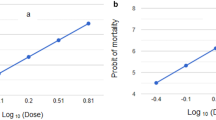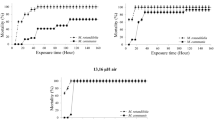Abstract
The chemical composition of a plant essential oil can be affected by many environmental and biological factors. Understanding the role of individual constituents as well as their interactions to the overall insecticidal bioactivity is prerequisite to the use of essential oils as an alternative to conventional insecticides. In the present study, the chemical compositions of plant essential oils obtained from Thymus vulgaris (thyme) and Cymbopogon citratus (lemongrass) were analyzed by gas chromatography/mass spectrometry, and the insecticidal and cytotoxic activities of individual constituents were evaluated against third instar larvae and an ovarian cell line of Trichoplusia ni. Thymol was the most abundant compound in thyme oil and the primary active constituent in contact and cytotoxicity tests, whereas p-cymene was the most effective compound for fumigant toxicity. In lemongrass oil, citral was identified as the major active and most abundant constituent. A weak correlation between insecticidal activity and cytotoxicity was observed, indicating limitation of the latter as a screening tool for novel insecticides. Although the evaporation of thymol was enhanced at higher temperatures, its contribution to fumigant activity was limited.







Similar content being viewed by others
References
Akhtar Y, Pages E, Stevens A, Bradbury R, Camara CAG, Isman MB (2012) Effect of chemical complexity of essential oils on feeding deterrence in larvae of the cabbage looper. Physiol Entomol 37:81–91
Asllani U, Toska V (2003) Chemical composition of Albanian thyme oil (Thymus vulgaris L.). J Essent Oil Res 15:165–167
Bakkali F, Averbeck S, Averbeck D, Idaomar M (2008) Biological effects of essential oils—a review. Food Chem Toxicol 46:446–475
Burt S (2004) Essential oils: their antibacterial properties and potential applications in foods-a review. Int J Food Microbiol 94:223–253
Choi WS, Park BS, Lee YH, Jang DY, Yoon HY, Lee SE (2006) Fumigant toxicities of essential oils and monoterpenes against Lycoriella mali adults. Crop Prot 25:398–401
Decombel L, Smagghe G, Tirry L (2004) Action of major insecticide groups on insect cell lines of the beet armyworm, Spodoptera exigua, compared with larvicidal toxicity. Vitro Cell Dev Biol-Anim 40:43–51
Desai MA, Parikh J, De AK (2014) Modelling and optimization studies on extraction of lemongrass oil from Cymbopogon flexuosus (Steud.) Wats. Chem Eng Res Des 92:793–803
Diaz-Montano J, Trumble JT (2013) Behavioral responses of the potato psyllid (Hemiptera: Triozidae) to volatiles from dimethyl disulfide and plant essential oils. J Insect Behav 26:336–351
Edris AE (2007) Pharmaceutical and therapeutic potentials of essential oils and their individual volatile constituents: a review. Phytother Res 21:308–323
González JOW, Stefanazzi N, Murray AP, Ferrero AA, Band BF (2014) Novel nanoinsecticides based on essential oils to control the German cockroach. J Pest Sci. doi:10.1007/s10340-014-0607-1
Hudaib M, Speroni E, Pietra AMD, Cavrini V (2002) GC/MS evaluation of thyme (Thymus vulgaris L.) oil composition and variations during the vegetative cycle. J Pharm Biomed Anal 29:691–700
Hummelbrunner LA, Isman MB (2001) Acute, sublethal, antifeedant, and synergistic effects of monoterpenoid essential oil compounds on the tobacco cutworm, Spodoptera litura (Lep., Noctuidae). J Agric Food Chem 49:715–720
Isman MB (2006) Botanical insecticides, deterrents, and repellents in modern agriculture and an increasingly regulated world. Annu Rev Entomol 51:45–66
Isman MB, Grieneisen ML (2014) Botanical insecticide research: many publications, limited useful data. Trends Plant Sci 19:140–145
Isman MB, Wilson JA, Bradbury R (2008) Insecticidal activities of commercial rosemary oils (Rosmarinus officinalis) against larvae of Pseudaletia unipuncta and Trichoplusia ni in relation to their chemical compositions. Pharm Biol 46:82–87
Janmaat AF, Myers J (2003) Rapid evolution and the cost of resistance to Bacillus thuringiensis in greenhouse populations of cabbage loopers, Trichoplusia ni. Proc R Soc Lond B 270:2263–2270
Jiang Z, Akhtar Y, Bradbury R, Zhang X, Isman MB (2009) Comparative toxicity of essential oils of Litsea pungens and Litsea cubeba and blends of their major constituents against the cabbage looper, Trichoplusia ni. J Agric Food Chem 57:4833–4837
Jiang ZL, Akhtar Y, Zhang X, Bradbury R, Isman MB (2012) Insecticidal and feeding deterrent activities of essential oils in the cabbage looper, Trichoplusia ni (Lepidoptera: Noctuidae). J Appl Entomol 136:191–202
Lang G, Buchbauer G (2012) A review of recent research results (2008-2010) on essential oils as antimicrobials and antifungals. A review. Flavour Fragr J 27:13–39
Lee BH, Choi WS, Lee SE, Park BS (2001) Fumigant toxicity of essential oils and their constituent compounds towards the rice weevil, Sitophilus oryzae (L.). Crop Prot 20:317–320
Leibee GL, Capinera JL (1995) Pesticide resistance in Florida insects limits management options. Fla Entomol 78:386–399
Machial CM, Shikano I, Smirle M, Bradbury R, Isman MB (2010) Evaluation of the toxicity of 17 essential oils against Choristoneura rosaceana (Lepidoptera: Tortricidae) and Trichoplusia ni (Lepidoptera: Noctuidae). Pest Manag Sci 66:1116–1121
Milks ML, Myers J (2003) Cabbage looper resistance to a nucleopolyhedrovirus confers cross-resistance to two granuloviruses. Environ Entomol 32:286–289
Miresmailli S, Bradbury R, Isman MB (2006) Comparative toxicity of Rosmarinus officinalis L. essential oil and blends of its major constituents against Tetranychus urticae Koch (Acari: Tetranychidae) on two different host plants. Pest Manag Sci 62:366–371
Moncada J, Tamayo JA, Cardona CA (2014) Techno-economic and environmental assessment of essential oil extraction from citronella (Cymbopogon winteriana) and lemongrass (Cymbopogon citrus): a Colombian case to evaluate different extraction technologies. Ind Crops Prod 54:175–184
Natural Resources Canada (2014) Cabbage looper (Trichoplusia ni). http://epe.lac-bac.gc.ca/100/201/301/weekly_checklist/2014/internet/w14-40-U-E.html/collections/collection_2014/rncan-nrcan/Fo124-9-2014-eng.pdf. Accessed 22 Dec 2014
Padmakumari KP, Sasidharan I, Sreekumar MM (2011) Composition and antioxidant activity of essential oil of pimento (Pimenta dioica (L) Merr.) from Jamaica. Nat Prod Res 25:152–160
Park IK, Kim JN, Lee YS, Lee SG, Ahn YJ, Shin SC (2008) Toxicity of plant essential oils and their components against Lycoriella ingenua (Diptera: Sciaridae). J Econ Entomol 101:139–144
Pavela R (2010) Acute and synergistic effects of monoterpenoid essential oil compounds on the larvae of Spodoptera littoralis. J Biopestic 3:573–578
Pavela R (2014) Acute, synergistic and antagonistic effects of some aromatic compounds on the Spodoptera littoralis Boisd. (Lep., Noctuidae) larvae. Ind Crops Prod 60:247–258
Pavlea R, Vrchotová N, Tříska J (2009) Mosquitocidal activities of thyme oils (Thymus vulgaris L.) against Culex quinquefasciatus (Diptera: Culicidae). Parasitol Res 105:1365–1370
Rani PU, Madhusudhanamurthy J, Sreedhar B (2014) Dynamic adsorption of α-pinene and linalool on silica nanoparticles for enhanced antifeedant activity against agricultural pests. J Pest Sci 87:191–200
Rasikari HL, Leach DN, Waterman PG, Spooner-Hart RN, Basta AH, Banbury LK, Forster PI (2005) Acaricidal and cytotoxic activities of extracts from selected genera of Australian Lamiaceae. J Econ Entomol 98:1259–1266
Regnault-Roger C, Hamraoui A (1995) Fumigant toxic activity and reproductive inhibition induced by monoterpenes on Acanthoscelides obtectus (Say) (Coleoptera), a bruchid of kidney bean (Phaseolus vulgaris L.). J Stored Prod Res 31:291–299
Regnault-Roger C, Vincent C, Arnason JT (2012) Essential oils insect control: low-risk products in a high-stakes world. Annu Rev Entomol 57:405–424
Robinson GS, Ackery PR, Kitching IJ, Beccaloni GW, Hernández LM (2010) HOSTS—a database of the World’s Lepidopteran hostplants. http://www.nhm.ac.uk/hosts. Accessed 22 Dec 2014
Senatore F (1996) Influence of harvesting time on yield and composition of the essential oil of a thyme (Thymus pulegioides L.) growing wild in Campania (Southern Italy). J Agric Food Chem 44:1327–1332
Sertkaya E, Kaya K, Soylu S (2010) Acaricidal activities of the essential oils from several medicinal plants against the carmine spider mite (Tetranychus cinnabarinus Boisd.) (Acarina: Tetranychidae). Ind Crops Prod 31:107–112
Suthisut D, Fields PG, Chandrapatya A (2011) Contact toxicity, feeding reduction, and repellency of essential oils from three plants from the ginger family (Zingiberaceae) and their major components against Sitophilus zeamais and Tribolium castaneum. J Econ Entomol 104:1445–1454
Veras HNH, Rodrigues FFG, Colares AV, Menezes IRA, Coutinho HDM, Botelho MA, Costa JGM (2012) Synergistic antibiotic activity of volatile compounds from the essential oil of Lippia sidoides and thymol. Fitoterapia 83:508–512
Vergis J, Gokulakrishnan P, Agarwal RK, Kuamr A (2013) Essential oils as natural food antimicrobial agents: a review. Crit Rev Food Sci Nutr. doi:10.1080/10408398.2012.692127
Zhang QH, Schneidmiller RG, Hoover DR (2013) Essential oils and their compositions as spatial repellents for pestiferous social wasps. Pest Manag Sci 69:542–552
Zheljazkov VD, Cantrell CL, Astatkie T, Cannon JB (2011) Lemongrass productivity, oil content, and composition as a function of nitrogen, sulfur, and harvest time. Agron J 103:805–812
Acknowledgments
The authors are grateful to Nancy Brad, Zyta Abramowski, and Lina Madilao for technical support.
Conflict of interest
The authors declare that they have no conflict of interest.
Ethical standard
This study does not contain any studies with animals, as defined by the University of British Columbia, performed by any of the authors.
Funding
This study was funded by a Discovery grant from the Natural Sciences and Engineering Research Council of Canada [2729–11] [to MBI] and a University of British Columbia graduate fellowship [to JHT].
Author information
Authors and Affiliations
Corresponding author
Additional information
Communicated by M. Traugott.
Rights and permissions
About this article
Cite this article
Tak, JH., Jovel, E. & Isman, M.B. Contact, fumigant, and cytotoxic activities of thyme and lemongrass essential oils against larvae and an ovarian cell line of the cabbage looper, Trichoplusia ni . J Pest Sci 89, 183–193 (2016). https://doi.org/10.1007/s10340-015-0655-1
Received:
Revised:
Accepted:
Published:
Issue Date:
DOI: https://doi.org/10.1007/s10340-015-0655-1




